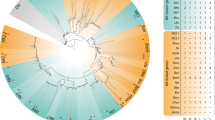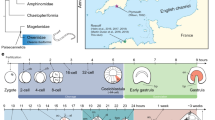Abstract
Abnormally developing embryos (ADEs) of the common pill millipede Glomeris marginata have been investigated by means of nuclear staining and mRNA in situ hybridization. It showed that all ADEs represent cases of Duplicitas posterior, which means that the posterior body pole is duplicated. The severity of the duplication ranges from duplicated posterior trunk segments in one specimen to an almost completely duplicated specimen that only shares the very anterior head region. Remarkably, none of the encountered ADEs represents a case of Duplicitas anterior (duplicated anterior pole) or a case of Duplicitas cruciata (cruciate duplication with two anterior and two posterior poles). This observation is discussed in the light of earlier reports on G. marginata ADEs that claim to have found these abnormalities. The lack of any other axial abnormality aside from D. posterior implies that early axis determination in G. marginata, and possibly myriapods in general, underlies the developmental mechanisms that prevent the formation of any other type of axial duplication. It is proposed that the formation of D. posterior-type embryos could be caused by the formation of two instead of only one posterior cumulus early during development.





Similar content being viewed by others
References
Alwes F, Scholtz G (2005) Stages and other aspects of the embryology of the parthenogenetic Marmorkrebs (Decapoda, Reptantia, Astacida). Dev Genes Evol 216:169–184
Balazuc J, Schubart O (1962) La tératologie des Myriapodes. Année Biol 1:145–174
Brauer A (1917) Ueber Doppelbildungen des Skorpion Euscorpius carpathicus L. Sitz Akad wiss Berlin, pp. 208–221, 12 figs
Chatton (1909) Sur un nauplius double anadydyme d’Ophioseides jouhini Chatton. Compt Rend Soc Biol Paris 67:482–484
Ceuca T (1989) Genul Glomeris Latr. 1802 in fauna de diplopode a Romaniei (cu cateva aspecte teratologice). Stud Univ Babes-Bolyai Biol 34:49–55
David R, Wedlich D (2001) PCR-based RNA probes, a quick and sensitive method to improve whole mount embryo in situ hybridization. Biotech 30:769–772
Dohle W (1964) Die Embryonalentwicklung von Glomeris marginata (Villers) im Vergleich zur Entwicklung anderer Diplopoden. Zool Jb Anat 81:241–310
Ehn A (1962) The development of spider embryos after centrifugation. Zool Bidrag Upps 35:339–368
Ehn A (1963) Effects of sulphydryl-blocking substances on development of spider embryos. Zool Bidrag Upps 36:49–76
Enghoff H, Dohle W, Blower JG (1993) Anamorphosis in millipedes (Diplopoda)—the present state of knowledge with some developmental and phylogenetic considerations. Zool J Linn Soc 109:103–234
Harlioglu MM (2002) The first report on the occurrence of twins in a freshwater crayfish, Pacifastacus leniusculus (Decapoda, Atacoidea). Folia Biol (Krakow) 50:215–216
Harzsch S, Benton J, Beltz BS (2000) An unusual case of a mutant lobster embryo with double brain and double ventral nerve cord. Arthropod Struct Dev 29:95–99
Heymons R (1897) Mittheilungen über die Segmentirung und den Körperbau der Myriopoden. Proc Königlich Preußischen Acad Sci Berlin 40:915–923
Heymons R (1901) Die Entwicklungsgeschichte der Scolopender. Zool Stuttg 13:1–244
Holm Å (1952) Experimentelle Untersuchungen ueber die Entwicklung und Entwicklungsphysiologie des Spinnenembryos. Zool Bidr Uppsala 29:293–424
Hubert M (1968) Sur des cas de monstruosités doubles observés chez des larves de Glomeris marginata (Villers) (Myriapode, Diplopode, Oniscomorphe, Glomeridia). Bull Soc Zool Fr 93:443–450
Itow T, Sekiguchi K (1979) Induction of multiple embryos with NaHCO3 or calcium free see water in the horseshoe crab. Wilhelm Roux Arch 187:245–254
Janssen R, Prpic NM, Damen WGM (2004) Gene expression suggests decoupled dorsal and ventral segmentation in the millipede Glomeris marginata (Myriapoda: Diplopoda). Dev Biol 268:89–104
Janssen R (2011a) An abnormally developed embryo of the pill millipede Glomeris marginata that lacks dorsal segmental derivatives. Dev Genes Evol 221:351–355
Janssen R (2011b) Diplosegmentation in the pill millipede Glomeris marginata is the result of dorsal fusion. Evol Dev 13:477–487
Janssen R, Budd GE, Damen WGM (2011) Gene expression suggests conserved mechanisms patterning the heads of insects and myriapods. Dev Biol 357:64–72
Juberthie C (1968) Teratologie experimentale chez un Opilion (Arachnide). J Embryol Exp Morph 19:49–82
Juberthie-Jupeau L (1962) Dédoublement de la region postérieure du corps chez une larve de Scutigerella pagesi Jupeau (Myriapodes, Symphyles). Bull Soc Zool Fr 86:732–736
Juberthie-Jupeau L (1968) Production experimentale de monsters doubles chez Glomeris marginata (Villers), Myriapode, Diplopode. C R Acad Sci Paris 266:1610–1612
Juberthie-Jupeau L (1969) Action teratogene de la temperature sur l’embryon de Glomeris marginata (Villers) (Myriapodes, Diplopodes). Bull Mus Nat Hist Natur, Supp: 79–84
Juberthie-Jupeau L (1974) Action de la température sur le développement embryonnaire de Glomeris marginata (Villers). Symp Zool Soc Lond 32:289–300
Kalthoff K, Sander K (1968) Der Entwicklungsgang der Missbildung “Doppelabdomen” im partiell UV-bestrahlten Ei von Smittia parthenogenetica (Dip., Chironomidae). Wilhelm Roux Arch 161:129–146
Kettle C, Arthur W, Jowett T, Minelli A (1999) Homeotic transformation in a centipede. Trends Genet 15:393
Krause G (1934) Analyse erster Differenzierungsprozesse im Keim der Gewächshausschrecke durch künstlich erzeugte Zwillings-, Doppel- und Mehrfachbildungen. Wilhelm Roux Arch Entwmech Org 132:115–205
Krause G, Krause J (1954) Induktion sekundärer Segmente bei der metameren Selbstgliederung der Insektenkeimanlage. Naturwissenschaften 41:235–236
Lesniewska M, Bonato L, Minelli A, Fusco G (2009) Trunk anomalies in the centipede Stigmatogaster subterranean provide insight in to late-embryonic segmentation. Arthropod Struct Dev 38:417–426
Minelli A, Pasqual C (1986) On some abnormal specimens of centipedes (Chilopoda). Lavori Soc Ven Sc Nat 11:135–141
Sander K (1988) Studies in insect segmentation: from teratology to phenogenetics. Develop 104(Suppl):112–121
Sander K (1997) Pattern formation in insect embryogenesis: the evolution of concepts and mechanisms. Int J Insect Morphol Embryol 25:349–367
Schnetter M (1934) Physiologische Untersuchungen über das Differenzierungszentrum in der Embryonalentwicklung der Honigbiene. Wilhelm Roux Arch Entwmech Org 131:285–323
Seitz KA (1970) Embryonale Defekt- und Doppelbildungen im Ei der Spinne Cupiennius salei (Ctenide). Zool Jb Anat Bd 87:588–639
Sekiguchi K (1957) Reduplication in spider eggs produced by centrifugation. Sci Rep Tokyo Kyoiku Daigaku Sect B 8-130:187–240
Selbie CM (1913) A new variety of Polydesmus coriaceus Porat, and note of a centipede monstrosity. Ann Mag Nat Hist 12:439–443
Yajima H (1960) Studies on embryonic determination of the harlequin-fly, Chironomus dorsalis. I. Effects of centrifugation and of its combination with constriction and puncturing. J Embryol Exp Morph 8:198–215
Acknowledgments
I would like to thank the members of the “Evolutionär organismbiologi” course Uppsala (2009), and here especially Patrik Båtelsson, who isolated and cloned the Glomeris spineless fragment under my supervision. Pictures in Fig. S1e–f and the Glomeris Distal-less clone were generously provided by Nikola-Michael Prpic-Schäper (Georg-August-Universität Göttingen, Germany). I would like to also thank Alessandro Minelli (University of Padova, Italy) and Muzaffer M. Harlioglu (University of Firat, Turkey) for providing rare literature. Finally, thanks to native speakers Aodhán D. Butler and Allison Perrigo for proofreading of the final version of the manuscript. Five anonymous reviewers are thanked for their helpful comments and constructive criticism.
Author information
Authors and Affiliations
Corresponding author
Additional information
Communicated by: Sven Thatje
Rights and permissions
About this article
Cite this article
Janssen, R. Developmental abnormalities in Glomeris marginata (Villers 1789) (Myriapoda: Diplopoda): implications for body axis determination in a myriapod. Naturwissenschaften 100, 33–43 (2013). https://doi.org/10.1007/s00114-012-0989-y
Received:
Revised:
Accepted:
Published:
Issue Date:
DOI: https://doi.org/10.1007/s00114-012-0989-y




